The Economics and Statistics Division maintains archives of previous publications for accountability purposes, but makes no updates to keep these documents current with the latest data revisions from Statistics Canada. As a result, information in older documents may not be accurate. Please exercise caution when referring to older documents. For the latest information and historical data, please contact the individual listed to the right.
<--- Return to Archive
For additional information relating to this article, please contact:
March 22, 2018NOVA SCOTIA QUARTERLY POPULATION ESTIMATES AS OF JANUARY 1, 2018 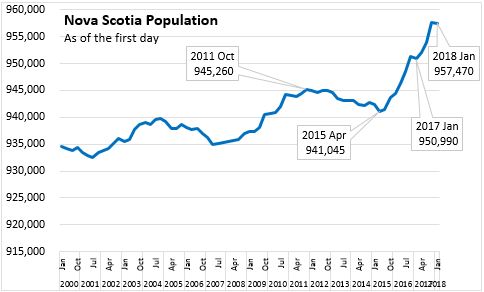
Nova Scotia’s population declined by 130 between October 1, 2017 and January 1, 2018. The population as of January 1, 2018 was 957,470. This follows the previous quarter which had the highest population estimate reported in Nova Scotia since October 2011. Since April 1, 2015 Nova Scotia's population has increased by 16,425. This quarter's decline is largely due to deaths outnumbering births and a decline in non-permanent residents, despite significant numbers of interprovincial and international migrants.
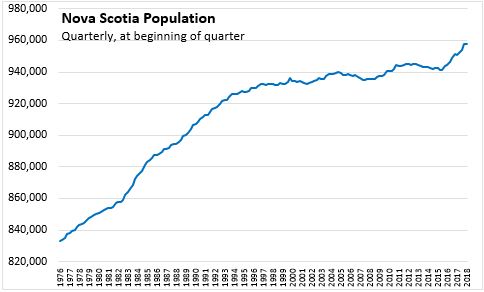
There are seasonal patterns in quarterly population changes, particularly evident in births and international migration. This quarter's decline is not uncommon for this period in Nova Scotia, with six of the last eight October to December periods showing declines.
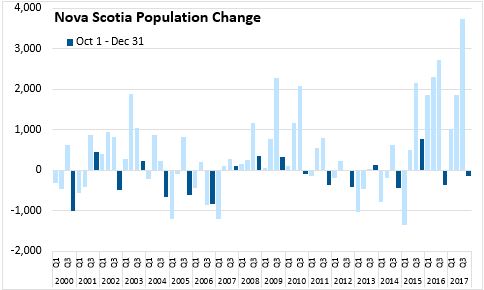
Population growth in Nova Scotia is typically slower than the national average pace. In the last quarter, Nova Scotia’s net population decrease amounted to 0.01 per cent of the population on October 1, 2017. The national population grew by 0.21 per cent over this period. Compared with January 1, 2017 Nova Scotia’s population has increased by 0.68 per cent, or 6,480, while the national population grew by 1.34 per cent.
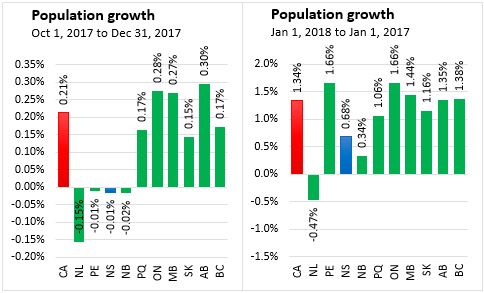
In recent quarters, immigration from other countries has been a strong contributor to population growth in Nova Scotia. Nova Scotia received 1,011 immigrants during the fourth quarter of 2017. This is a decline over the previous quarter, but is the largest number of immigrants in quarter four since 1973.

Nova Scotia’s natural population change (the number of births, less the number of deaths) has been negative for several years, with the exception of the regular Q3 increase in births. Between October 1, 2017 and December 31, 2017, there were 2,046 births and 2,387 deaths, amounting to a natural population decline of 341.
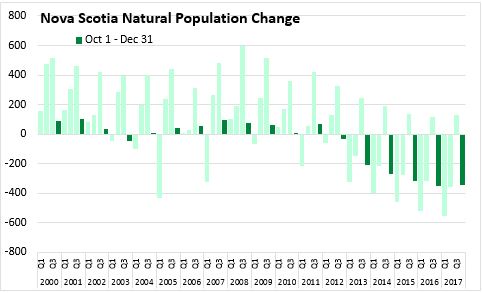
Interprovincial migration has typically been a drain on Nova Scotia’s population. However, from October 1, 2017 to December 31, 2017 there was a net inflow of 305 interprovincial migrants from Nova Scotia. This is the fourth consecutive quarter with positive gains, where the previous quarter had the largest net interprovincial migration since 2003.
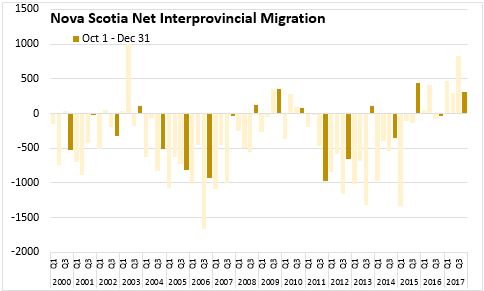
Outmigrants from Nova Scotia to other provinces fell once again over this quarter. Out-migration slowed for New Brunswick, and British Columbia, while there were increases in Nova Scotians leaving for Ontario and Quebec compared to previous years. There was an increase in the number of Nova Scotians leaving for Alberta, although it was smaller than has been seen in previous years.
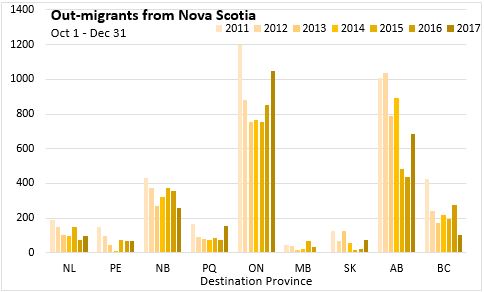
In-migrants to Nova Scotia were once again largest from Ontario, New Brunswick, and Alberta. There was a notable increase in migrants from Ontario compared to previous fourth quarter movements.
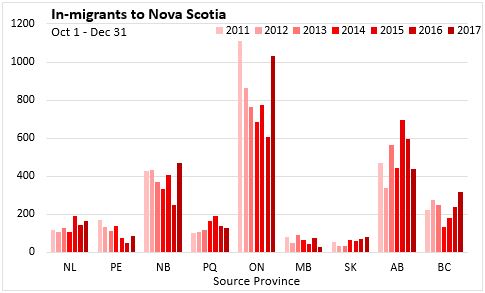
This quarter, Nova Scotia's net interprovincial migration with Alberta has switched back to an outflow (the previous two fourth quarters were net inflows), while the net outflow to Saskatchewan has become an inflow. The net inflow from New Brunswick, Ontario, and British Columbia have had the highest increases this quarter.
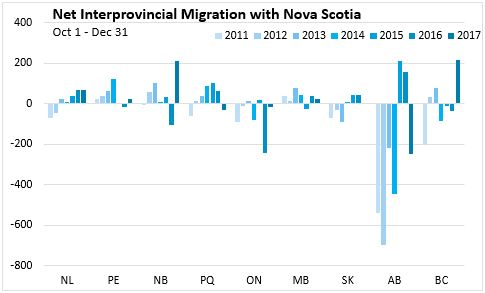
The number of non-permanent residents in Nova Scotia from October 1 to December 31 declined from the previous quarter's record high to 20,061. Even so, this quarter's number of non-permanent residents is the second highest on record.
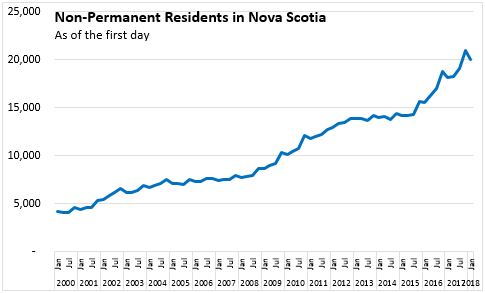

Annual January 1, 2017 to January 1, 2018
From January 1, 2017 to January 1, 2018, Nova Scotia's population increased by 6,480. Over the course of the year, the number of deaths continued to outweigh the number of births, resulting in a natural population decline of 1,126. Since 2008, the natural population change has been on a downward trend. (Note that Statistics Canada releases population estimates as of July 1 of each year, while this analysis provides a four-quarter snapshot of population trends by calendar year.)
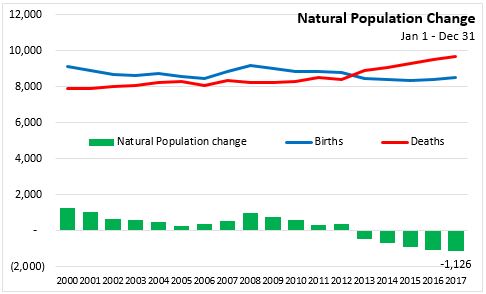
In 2017, Nova Scotia lost 15,728 migrants to other provinces but received 17,617 migrants from other provinces, amounting to positive net interprovincial migration of 1,889. This is the largest net interprovincial migration seen since 1984, a continuation of the upward trend seen since 2012. Net international migration in 2017 was 5,717, less than the recent peak in 2016 of 7,260.

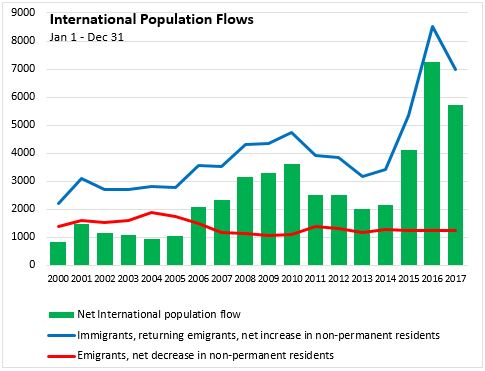
Statistics Canada Cat. No. 91-215
Source:
Quarterly Demographic Estimates, Statistics Canada. Pub 91-002-X (free)
Statistics Canada CANSIM tables: 051-0005 (Population estimates), 051-0017 and 051-0045 (Interprovincial Migrants), 053-0001 (Births and Deaths), 051-0037 (International Migrants)
<--- Return to Archive